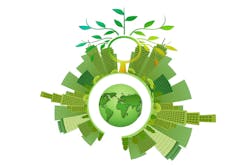Kontrol gets into net zero building infrastructure market via Global buy
Smart building technologies specialist Kontrol Technologies Corp. (Toronto) today announced its entry into the net zero building infrastructure market through its recently acquired operating subsidiary Global HVAC and Automation (aka Global).
Paul Ghezzi, CEO of Kontrol Technologies Corp., explained:
“Following our acquisition of Global, we have been focused on the many opportunities afforded by Global’ s scale and size. In the past, Global has focused on traditional energy efficient HVAC installations for new buildings. We are now pleased to offer our customers net zero buildings solutions including VRV/VRF systems and geothermal installations. Through these solutions we seek to grow our market share with our existing new construction customers and add those customers who seek to reduce their emissions and achieve net zero emissions. Global has completed its first integrated installation of VRV/VRF technology and is now in a position to grow into this exciting new market which will also make a significant impact on the reduction of GHG emissions.”
VRV/VRF technology integration facts
As noted by a Kontrol statement, variable refrigerant flow (VRF), also known as variable refrigerant volume (VRV), is an HVAC technology invented by Daikin Industries, Ltd. in 1982. VRFs use refrigerant as the cooling and heating medium. This refrigerant is conditioned by one or more condensing units and is circulated within the building to multiple indoor units.
Unlike conventional chiller-based systems, VRV/VRF allows for varying degrees of cooling and in more specific areas may supply hot water in a heat recovery configuration while improving overall building energy efficiency.
Also, air handlers and large ducts are eliminated which can reduce the height above a dropped ceiling as well as structural impact as VRF uses smaller penetrations for refrigerant pipes instead of ducts. This translates into lower integration costs and higher energy savings with a corresponding reduction in greenhouse gas emissions.
Geothermal technology boosts high rise buildings
As also announced today by Kontrol, Global will commence quoting geothermal technology solutions to their customers in Q4, 2021. The company contends that geothermal heating and cooling systems have a significant potential to reduce the energy footprint and environmental impact of buildings.
As stated by Kontrol:
In addition to offering the highest efficiency among the HVAC options commercially available, geothermal systems eliminate on-site fossil fuel combustion. In addition, increasing regulations around emissions are creating opportunities for Geothermal localized distribution plants to offer a clean source of renewable energy that unlike solar and wind energy, can be scaled to match a buildings overall size and energy demands.
As further cited by the company, according to recent analysis from Global Market Insights, the geothermal market is anticipated to grow to $50 Billion USD per annum in 2027.
Finally, as usefully defined per Kontrol, "according to the World Building Council, the building sector, which is responsible for global emissions roughly equivalent to that of China, must operate at 'net zero carbon' by 2050 if global warming is to remain under two degrees Celsius, the limit enshrined in the Paris Agreement."
Visit www.kontrolcorp.com.

